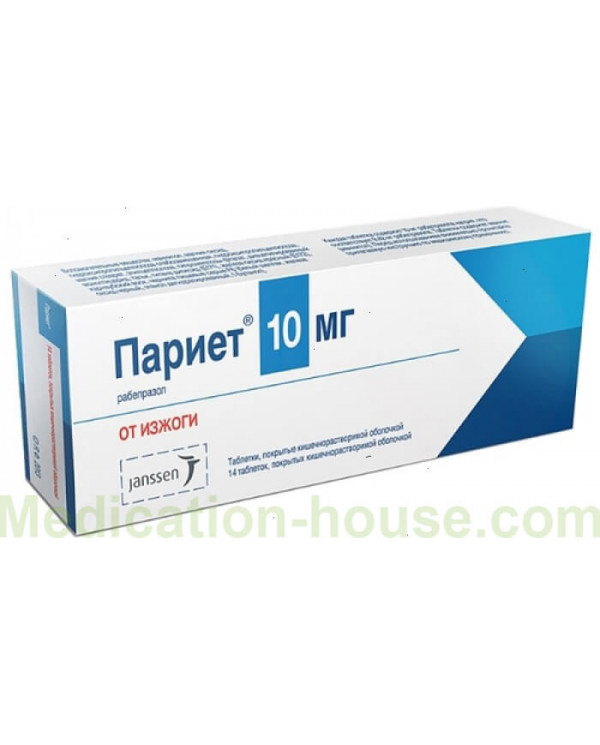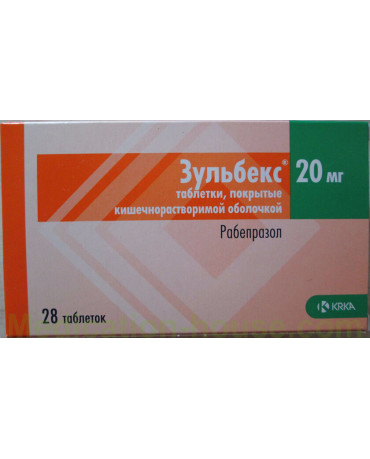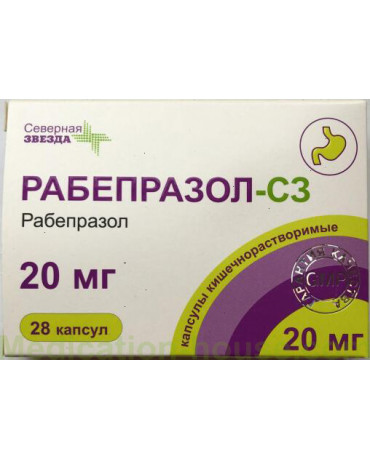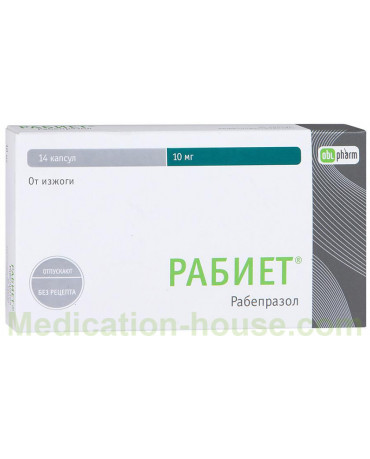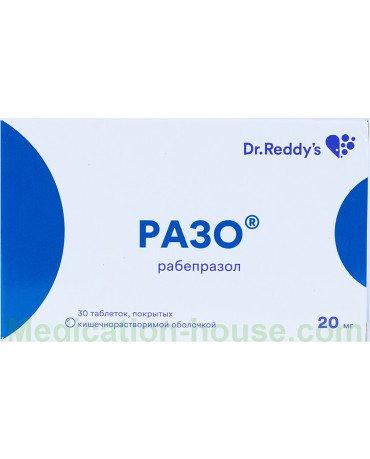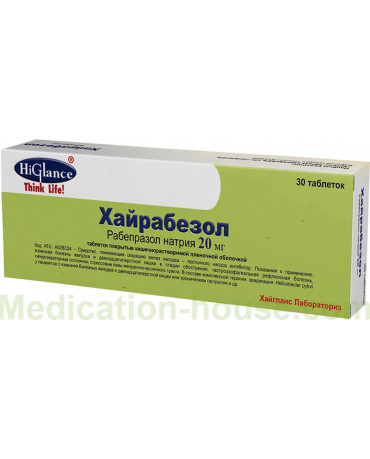Forms of release, names and composition
Currently, the drug is available in a single dosage form - enteric-coated tablets. However, there are two dosages of tablets - 10 and 20 mg of the active substance, respectively. Due to the different dosages of the active substance in everyday speech, the names "Pariet 10" and "Pariet 20" are often used for their brief designation. In these names, the figure reflects the dosage of the tablets.
Each tablet contains either 10 mg or 20 mg of rabenprazole as the active substance. As auxiliary components, 10 mg and 20 mg tablets of rabenprazole contain the same substances, such as:
Mannitol;
Magnesium oxide;
Hyprolose and low-grade hyprolose;
Magnesium stearate;
Ethyl cellulose;
Hypromellose phthalate;
Diacetylated monoglyceride;
Talc;
Titanium dioxide;
Iron oxide red (for 10 mg tablets);
Iron oxide yellow (for tablets 20 mg);
Anhydrous ethanol;
Purified water;
Carnauba wax;
Food grade gray ink (for 10 mg tablets);
Food grade red ink (for 20 mg tablets);
Butanol
Tablets containing 10 mg of rabenprazole are pink in color, have a round, biconvex shape and are marked with ink "∈241" on one side. Tablets containing 20 mg of rabenprazole also have a round, biconvex shape with the marking "∈ 243" on one side, but they are painted in light yellow. Pariet is available in packs of 7, 14 and 28 pieces.
Manufacturer
Due to the numerous distribution chains and the spread of outsourcing in the pharmaceutical industry, many people cannot understand who the manufacturer of this or that drug is, based on the corresponding inscriptions on the package or in the package insert with instructions for use. This fully applies to Pariet. Consider what the instructions on the packaging and in the leaflets mean, and who the manufacturer of the drug is.
So, on the leaflet or on the box of the drug you can see the following information about the manufacturers:
Johnson & Johnson (Russia);
EISAI, Co. Ltd. (Japan);
CILAG, AG (Switzerland).
The real manufacturer of the drug is EISAI. That is, the tablets are made in Japan. But the Japanese concern EISAI makes tablets for the company Johnson & Johnson, which owns the registration certificate for the drug. This means that Johnson & Johnson owns the rights to use the name Pariet, as well as all production technology. And CILAG produces only Pariet tablet packaging, the design and quality of which are agreed and approved by Johnson & Johnson.
That is, the patent holder Johnson & Johnson gives a contract for the manufacture of tablets to one company (Japanese EISAI), and the packaging to a second (Swiss CILAG), and all of them are indicated on the insert leaflet as manufacturers. But only the owner of the registration certificate is responsible for the quality of the drug and accepts all claims against it - that is, Johnson & Johnson. Thus, the legal manufacturer of Pariet is Johnson & Johnson, and physically the Japanese pharmaceutical plant EISAI.
Absorption, distribution and removal of the drug from the body
The drug is rapidly absorbed into the bloodstream from the intestinal lumen, and the maximum concentration of the active substance in the blood is reached 3.5 hours after administration. However, taking the drug in combination with fatty foods slows its absorption up to at least 4 hours. In total, approximately 52% of the dose taken is absorbed. The half-life (the time during which half of the injected dose of the drug is removed from the body) of Pariet is 1 hour, and in people suffering from liver failure - 2 to 3 hours. In older people, Pariet is excreted somewhat more slowly, but the accumulation of the drug in the tissues of the body does not occur, therefore, it is not necessary to reduce the dosage.
After absorption into the bloodstream, about 97% of the drug binds to plasma proteins and in this form is transported to the stomach. After the effect has been achieved, the drug with a flow of venous blood is removed from the stomach and enters the liver, where its active substance breaks down into two metabolites - mercapturic acid and carboxylic acid, which, in turn, are excreted by urine by 90%. Only 10% of Pariet is excreted in the feces also in the form of metabolites.
Scope and therapeutic effect
The drug has one main clinical effect - antiulcer. That is, the drug is able to prevent the formation and heal of already existing ulcerative defects of the stomach, duodenum and esophagus. It is this clinical effect that determines the scope of Pariet - this is the treatment of gastric ulcer, duodenal ulcer and gastroesophageal reflux disease (GERD), as well as the prevention of ulceration.
The clinical antiulcer effect is due to the following pharmacological effects of the drug:
The antisecretory effect of suppressing the production of hydrochloric acid by the glands of the stomach. A decrease in the production of hydrochloric acid is achieved due to the deactivation of the proton pump, which is one of the main structural and functional components of the gastric glands. As a result of the action of Pariet, hydrochloric acid is produced in a much smaller amount, and the acidity of the gastric juice decreases, which contributes to the healing of the ulcer defect and the elimination of reflux into the esophagus. Antisecretory action lasts from 23 to 48 hours after a single dose of 20 mg of Pariet;
Reparative effect, which consists in normalizing the structure of cells and tissues of the stomach and esophagus with the destruction of damaged and inflamed cells. So, according to a study of histological samples of tissues of the stomach and esophagus taken after treatment with Pariet, they lacked cells characteristic of gastritis, atrophy, intestinal metaplasia, or helicobacteriosis.
Indications for use
10 mg tablets
Indications for the use of tablets 10 mg are the following conditions or diseases:
Elimination of any symptoms associated with increased acidity of the gastric juice (for example, heartburn, belching sour, sensation of acid in the mouth);
Symptomatic treatment of gastroesophageal reflux disease (GERD), which occurs without esophagitis.
In principle, tablets 10 mg are indicated for use only for symptomatic therapy of GERD, that is, to eliminate the painful manifestations of the disease, but not treatment.
20 mg tablets
Tablets 20 mg are indicated for use in the treatment and prevention of various diseases associated with increased acidity of gastric juice, such as:
Exacerbation of gastric ulcer of any etiology;
Exacerbation of peptic ulcer of the duodenum of any etiology;
Peptic ulcer of the stomach and duodenum associated with Helicobacter pylori at any stage;
Anastomosis ulcer;
Erosive or ulcerative form of gastroesophageal reflux disease (GERD);
Non-erosive form of GERD;
Reflux esophagitis;
Stress ulcers of the digestive tract;
Supportive therapy for gastroesophageal reflux disease aimed at preventing relapse;
Zollinger-Ellison Syndrome;
Idiopathic hypersecretion of hydrochloric acid;
As part of a combination of eradication therapy, conducted to treat gastritis and peptic ulcer of the stomach or duodenum associated with Helicobacter pylori;
Prevention of relapse of gastritis or peptic ulcer of the stomach and duodenum associated with Helicobacter pylori.
Instructions for use
Tablets should be taken orally, swallowing whole, without chewing, without breaking or crushing in other ways. The drug must be washed down with a sufficient amount of non-carbonated clean water (at least half a glass). Time of day and food intake do not affect the absorption of Pariet. Therefore, the drug can be taken regardless of the time of food intake and at any time of the day. However, you should observe the same intervals between Pariet's receptions, for example, drink a pill every day at the same time.
Instructions for use tablets 10 mg
Tablets 10 mg should be taken once a day. To maintain a constant time interval between Pariet's meals, it is recommended that you take tablets in the morning before breakfast. If the condition has not improved during the first three days of therapy, you should stop taking the drug and consult a doctor. The maximum allowable duration of use of Pariet without consulting a doctor is two weeks.
Tablets 10 mg should be taken once a day as a maintenance therapy for GERD in order to prevent relapse. In addition, Pariet 10 mg is taken once a day with a non-erosive form of gastroesophageal reflux disease to eliminate painful symptoms. In both cases, Pariet 10 mg is taken for a long period of time (several months).
Instructions for use tablets 20 mg
Tablets 20 mg are taken for the treatment and prevention of GERD, peptic ulcer of various etiologies and stress ulcers in various dosages and for a different period of time. That is, the frequency of administration and the duration of the course of treatment with Pariet 20 mg is determined by the type of disease.
In case of gastric ulcer in the acute stage or an ulcer of the anastomosis, the drug should be taken 20 mg (1 tablet) once a day for 6 weeks. In the absence of effect, the duration of therapy is extended for another 6 weeks without any interruption.
In the treatment of peptic ulcer of the stomach or duodenum associated with Helicobacter pylori, it is necessary to take Pariet 20 mg (1 tablet) 2 times a day for 2 to 4 weeks, in combination with antibiotics. If necessary, the course of taking Pariet can be extended for another 4 weeks.
When treating an erosive form of GERD or reflux esophagitis, it is necessary to take Pariet at 20 mg (1 tablet) per day for 4 to 8 weeks, depending on the rate of disappearance of symptoms. If after treatment the symptoms still persist, then the course of taking Pariet is extended for another 8 weeks.
After the main course of treatment of GERD, it is necessary to take Pariet at 20 mg once a day for a long time (from several months to a year) as maintenance therapy aimed at preventing relapse.
When treating a non-erosive form of gastroesophageal reflux disease, it is necessary to take Pariet 20 mg (1 tablet) once a day for 4 weeks. If after treatment the symptoms did not stop, an additional examination should be carried out in order to clarify the diagnosis. After the GERD has been cured and the condition normalized, it is necessary to switch to Pariet at a dose of 20 mg (1 tablet) in the “on demand” mode, that is, drink the tablet only when there are symptoms of excess acidity of the gastric juice (for example, belching sour, sensation of acid in the mouth , heartburn, etc.).
In the treatment of Zollinger-Ellison syndrome, it is necessary to select the dosage of the drug individually. The minimum initial dosage is 60 mg (3 tablets) 1 time per day. In this dose, the drug is taken for three days, and if the symptoms do not stop, then it is increased by 20 mg (1 tablet). Again, the drug is taken for three days, and if the symptoms have not passed again, then the dosage is increased by another 20 mg. In this way, the dosage of Pariet is selected, upon reception of which the symptoms will be stopped. You can bring the dosage to the maximum allowable of 100 mg once a day. The duration of therapy depends on the speed of recovery and ranges from several months to a year.
With renal or mild to moderate degree of liver failure, as well as in the elderly, the dosage of the drug should not be reduced. Dosage reduction may be required only for people suffering from severe liver failure.
The safe use of the drug in children over 12 years old, confirmed by extrapolation methods, is possible only at a dosage of 20 mg (1 tablet), taken once a day for 8 or less weeks in a row. The use of the drug in children from 12 to 18 years of age in large dosages or for longer than 8 weeks cannot be considered absolutely safe. Therefore, if necessary, increase the dose above 20 mg per day and lengthen the course of therapy for more than 8 weeks, the child should be under constant medical supervision.
The drug should not be taken simultaneously with other drugs that reduce the acidity of the gastric juice, such as H2 receptor blockers (Ranitidine, Famotidine) or proton pump inhibitors (Omeprazole, Lansoprazole, etc.).
During pregnancy and breastfeeding
In experimental animal studies, no adverse effects of the drug on the fetus were detected. However, in rats, the drug is able to penetrate through the placenta to the fetus in small concentrations. Similar clinical trials on pregnant women have not been conducted for obvious ethical reasons, therefore, scientifically confirmed data on the safety of Pariet for the fetus do not exist. That is why Pariet is not recommended for pregnancy. However, if for some reason a pregnant woman needs to take Pariet, then this can only be done if the intended benefit exceeds all possible risks.
It is not known whether the drug passes into breast milk, since similar studies have not been conducted in nursing women. However, according to studies in rats, it was found that the drug penetrates the milk of lactating females. Therefore, you can not use Pariet with breastfeeding, you should either postpone the treatment, or transfer the child to artificial mixtures.
Attention
The drug does not affect the ability to control various mechanisms, including driving a car, therefore, against the background of taking the drug, you can engage in any type of activity related to the need to concentrate. However, as a side effect, Pariet can provoke drowsiness, upon the appearance of which you should refuse to drive a car and other activities that require concentration and a high concentration of attention.
Overdose
An overdose of the drug was never detected during the entire period of use of the drug. Even a single dose of 80-100 mg of the drug did not cause overdose symptoms.
Interaction with other drugs
The drug does not interact with liquid antacids (for example, Maalox, Fosfalugel, etc.), so they can be taken simultaneously. However, the drug reduces ketoconazole absorption by 33% and increases digoxin by 22%. Therefore, when using Pariet simultaneously with ketoconazole or digoxin, it is necessary to increase the dosage of the first by one third and reduce the dose of the second by 20%.
The drug significantly reduces the absorption of atazanavir and other drugs used to treat HIV / AIDS, so they can not be used simultaneously.
Treatment for heartburn
Heartburn is a symptom of increased acidity of gastric juice, which is thrown from the stomach into the esophagus through a loose valve. This reflux of gastric contents is called reflux. Physiological refluxes normally occur in any healthy person several times a day, but they do not cause any unpleasant symptoms. If reflux causes heartburn, then this indicates excessive acidity of the gastric juice. In such a situation, this is not a simple functional disorder, but a pathology called gastroesophageal reflux disease (GERD) and requires some treatment depending on its severity and form, which is established during the examination.
If a person suffers from a non-erosive GERD, then for the treatment of heartburn it is necessary to take 10 mg or 20 mg of the drug once a day for 4 weeks continuously. After a course of therapy, you can switch to taking Pariet 20 mg "on demand", that is, when there is heartburn, a person drinks one tablet. Such a “on demand” preparation may last for years, but it should be examined 2–3 times a year and observed by a gastroenterologist.
If a person suffers from an erosive form of GERD or GERD with esophagitis (reflux esophagitis), then he needs to take Pariet 20 mg once a day for 8 weeks. Then you can switch to supportive treatment, which consists in taking Pariet 10 mg or 20 mg once a day for several months.
A single, episodic use of the drug for stopping heartburn is not rational, since the drug only works with course use. If it is necessary to stop recurring heartburn and there is no way to undergo a full course of treatment, then antacids should be used, such as Maalox, Almagel, Fosfalugel, Renny, etc.
Side effects
Tablets 10 and 20 mg are capable of provoking the development of the same side effects, so we list them all in one list. So, the following are related to the side effects of the drug:
1. On the part of the immune system: Acute allergic reactions (Quincke's edema, urticaria, shortness of breath, etc.).
2. From the blood system:
Thrombocytopenia (a decrease in the total number of platelets in the blood);
Neutropenia (decrease in the number of stab and segmented neutrophils in the blood);
Leukopenia (a decrease in the total number of white blood cells in the blood).
3. From the side of metabolism:
Hypomagnesemia (a decrease in the concentration of magnesium in the blood);
Weight gain;
Anorexia.
4. From the liver and biliary tract:
Increased activity of AcAT, AlAT and alkaline phosphatase;
Hepatitis;
Hepatic encephalopathy;
5. From the digestive tract:
Abdominal pain;
Diarrhea;
Constipation;
Flatulence (bloating);
Dry mouth;
Stomatitis;
Taste perversion.
6. From the central nervous system:
Headache;
Dizziness;
Drowsiness;
General weakness;
Asthenia;
Depression;
Insomnia.
7. From the urinary system:
Interstitial nephritis;
Edema.
8. From the skin and soft tissues:
Rash;
Hives;
Erythema multiforme;
Toxic epidermal necrolysis;
Stevens-Johnson Syndrome;
Excessive sweating.
9. From the musculoskeletal system:
Muscle pain (myalgia);
Joint pain (arthralgia);
Backache;
Cramps in the calf muscles.
10. From the reproductive system: Gynecomastia.
11. On the part of the organs of vision: Visual impairment.
12. Others:
Temperature rise;
Pharyngitis;
Rhinitis;
Flu-like syndrome.
Based on a long period of observation of the clinical use of the drug, it is safe to say that the drug is well tolerated and rarely causes any side effects. If any side effects are manifested, then they are mild and quickly pass.
The most dangerous side effect of the drug can be hypomagnesemia, when, due to the low concentration of magnesium in the blood, a person develops cramps and arrhythmia. When taking the drug for 3 months or more, it is necessary to take a magnesium preparation.
In addition, according to data obtained during clinical observations of the use of the drug, the risk of bone fractures increases with the drug.
Contraindications
The drug is contraindicated in the presence of the following diseases or conditions:
Individual hypersensitivity or allergic reactions to the active and auxiliary components of the drug;
Pregnancy;
Period of breastfeeding;
Children under 18 years of age for Pariet tablets 10 mg;
Children under 12 years of age for Pariet tablets 20 mg.
The listed contraindications to the use of the drug are absolute, that is, if they are available, the drug should not be used, under any circumstances. In addition to absolute, there are also relative contraindications for Pariet tablets of each dosage, in the presence of which the drug can be used, but with caution and under the close supervision of a doctor. A relative contraindication for Pariet 20 mg is a child's age from 12 to 18 years, and for tablets containing 10 mg of the active substance, severe renal failure.
Reviews
Approximately 2/3 of the reviews about the drug are positive, and the remaining 1/3 are negative. Positive reviews about the drug are due to its high effectiveness and the rapid elimination of painful symptoms that once disappearing, no longer appear. In addition, people say that Pariet is very convenient to take, side effects are either absent or so slightly expressed that they can be safely ignored. Also, the advantages of the drug are attributed by people to its ability to cure stomach diseases, for which the drug was prescribed. However, the high cost is a limiting factor in using Pariet, but people who decide to try the drug say that it justifies its price.
Negative reviews about the drug are associated with the appearance of side effects that are subjectively difficult to tolerate by specific people. Since side effects made people nervous, their health worsened, they became disappointed in Pariet and left negative feedback about it. There are practically no reviews in which people would talk about the ineffectiveness of the drug.
Terms of sell
You don't need a prescription from a doctor to buy Pariet.

